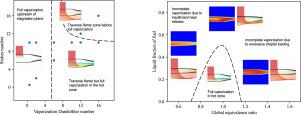Effect of liquid droplets on premixed laminar acetone flames
IF 5
Q2 ENERGY & FUELS
引用次数: 0
Abstract
The effects of fuel droplets on premixed laminar counterflow acetone flames are numerically investigated, and parametric studies are conducted for a range of monodisperse droplet sizes, equivalence ratios, and liquid fractions of fuel. A point-source Lagrangian framework is adopted for droplet calculations coupled with the Eulerian gas-phase solution. The particular geometric arrangement is created to mirror an experimental setup for flames with a global stoichiometric air fuel ratio, and a liquid mass fuel fraction of around 10%. The simulated flame generally appears as a one-dimensional structure under stoichiometric conditions for all the droplet sizes studied. Small droplets are found to vaporize in the vicinity of the flame front, while large droplets cross the flame and oscillate about the stagnation plane while vaporizing in the product zone. Under globally lean conditions, the local droplet vaporization leads to local enrichment and slightly higher temperatures and flame acceleration. Under rich conditions and larger liquid fractions, however, temperature decreases from fuel vaporization are not compensated by local heat release, and local deceleration occurs. The vaporization of droplets in the post-flame zone introduces fuel into products, creating a rich area and leading to further reactions to produce more CO and less CO2. Increases in droplet diameter lead to survival of droplets across the flame, which are eventually dragged back towards the flame for final vaporization and exit. Comparison with experimental measurements of velocities along the centerline with simulations results using incoming measured polydisperse droplet distributions show that agreement is only fair, and that it may be important to capture the cooling effects on the spray side with high accuracy temperature and droplet number measurements, as pre-cooling may affect the initial boundary conditions.

液滴对预混合层流丙酮火焰的影响
对燃料液滴对预混合层流逆流丙酮火焰的影响进行了数值研究,并对单分散液滴尺寸、当量比和燃料液体馏分进行了参数化研究。液滴计算采用点源拉格朗日框架,并结合欧拉气相解。特殊的几何排列是为了反映火焰的实验设置,具有全球化学计量空气燃料比,液体质量燃料分数约为10%。对于所研究的所有液滴尺寸,在化学计量条件下,模拟火焰通常表现为一维结构。发现小液滴在火焰前缘附近蒸发,而大液滴在产品区蒸发时穿过火焰并绕滞止面振荡。在整体稀薄条件下,局部液滴汽化导致局部富集,温度略高,火焰加速。然而,在丰富的条件和较大的液体馏分下,燃料汽化引起的温度下降并没有被局部热释放所补偿,而是发生了局部减速。火焰后区域液滴的蒸发将燃料引入产品,创造一个丰富的区域,并导致进一步的反应,产生更多的CO和更少的CO2。液滴直径的增加导致液滴在火焰中存活,最终被拖回火焰进行最终蒸发和出口。中心线速度的实验测量结果与多分散液滴分布的模拟结果的比较表明,两者的一致性仅是公平的,并且由于预冷却可能会影响初始边界条件,因此通过高精度的温度和液滴数测量来捕捉喷雾侧的冷却效果可能很重要。
本文章由计算机程序翻译,如有差异,请以英文原文为准。
求助全文
约1分钟内获得全文
求助全文

 求助内容:
求助内容: 应助结果提醒方式:
应助结果提醒方式:


